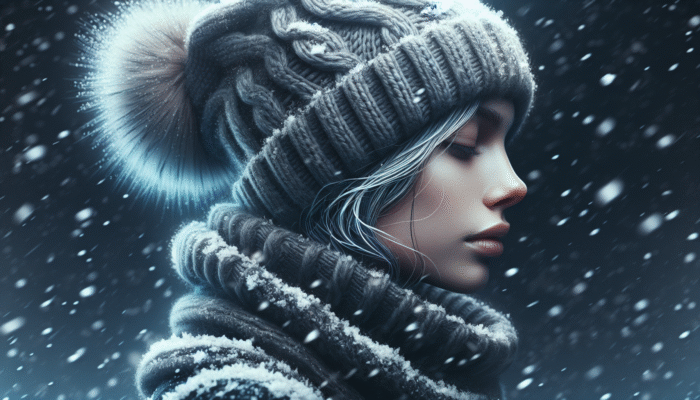Effective Strategies to Protect Your Hair from Winter's Harsh Elements
Adapting Your Hair Care Regimen for the Winter Months: The colder months introduce specific challenges for maintaining vibrant and healthy hair, making it essential to modify our hair care practices accordingly. As temperatures drop, the air becomes increasingly dry, which can strip your hair of crucial moisture, leading to severe damage. To navigate these harsh conditions successfully, it is important to implement a comprehensive strategy for adapting your hair care regimen for winter that prioritises both the health and vitality of your locks.
Selecting Breathable Headgear to Shield Your Hair from the Cold

Choosing appropriate headgear is paramount for shielding your hair from the unforgiving elements of winter. During especially cold spells, it is advisable to select hats made from breathable materials such as cotton or wool blends. These fabrics allow your scalp to ventilate, thereby reducing moisture accumulation that can promote fungal growth or result in oily roots. While trendy, restrictive hats may seem appealing, prioritising comfort and the overall health of your hair will ultimately yield the best outcomes for its condition.
Opt for hats that feature a soft lining to minimise friction against your hair. The friction caused by synthetic materials can lead to breakage and split ends, compounding the already challenging winter conditions. Furthermore, ensure that the hat is comfortably fitted without being excessively tight. A hat that is too snug can cause traction alopecia, a condition marked by undue pulling on hair follicles, potentially leading to hair thinning.
With a plethora of styles available, seek options that reflect your personal aesthetic while still offering necessary protection. Fashionable beanies, stylish berets, and wide-brimmed hats can all act as chic barriers against biting winds, effectively safeguarding your hair from the damage inflicted by the cold.
Hydrating Your Hair Before Braving the Cold Outdoors
Before venturing into the frigid outdoors, it is crucial to layer your hair with moisture to preserve its health. Applying a leave-in conditioner or a natural oil can create a protective barrier that helps to seal in hydration and avert dryness. Look for leave-in treatments infused with ingredients like argan oil or shea butter, both of which are celebrated for their nourishing properties that provide essential hydration for your hair.
When applying these products, concentrate on the mid-lengths and ends of your hair, as these areas are typically the most vulnerable to dryness and damage. Additionally, consider using a hair serum that not only imparts shine but also offers additional protection. These products hydrate your hair while forming a barrier against cold air and environmental stressors that could lead to further damage.
For those with particularly dry or curly hair, choosing a heavier cream or oil can be advantageous for ensuring sufficient moisture retention. Consistency is key; make this hydrating step a staple of your pre-exit routine to uphold the health of your hair throughout the winter months.
Reducing Shampoo Frequency to Avoid Over-Washing
In the pursuit of cleanliness, many individuals tend to wash their hair excessively, which can strip away the essential natural oils crucial for protection. During colder spells, it is beneficial to reduce the frequency of shampooing. Instead of washing your hair daily, aim to establish a routine of two to three times a week, allowing your scalp to retain its natural oils that serve as a barrier against harsh environmental factors.
When it is time to cleanse your hair, opt for a gentle, sulfate-free shampoo specifically formulated to hydrate and nourish. These mild formulations cleanse without completely depleting your hair of its vital moisture, helping to maintain a healthy equilibrium. If your hair feels oily between washes, consider utilising a dry shampoo to absorb excess oil without the need for additional washing.
By limiting the number of washes, you will support the natural balance of your scalp and hair, fostering healthier strands that are better equipped to withstand the cold. This simple adjustment to your routine can lead to significant benefits in preserving your hair's vitality throughout the winter months.
Embracing Protective Hairstyles for Enhanced Hair Safety

Protecting your hair from cold winds is essential, and incorporating protective hairstyles can significantly bolster your hair’s resilience. Styles such as braids, buns, or twists not only defend your hair against the elements but also reduce the risk of breakage. These hairstyles effectively tuck your ends away, shielding them from the drying air that winter inevitably brings.
Adopting protective hairstyles can also save you valuable time in your daily routine. Rather than spending time styling your hair each day, a well-executed protective style can last for several days or even up to a week, allowing you to focus on other responsibilities during the busy winter season.
Feel free to explore a variety of protective hairstyles that align with your hair type and personal style. Ensure that you use gentle hair ties that won’t cause damage or breakage. Additionally, incorporating accessories such as silk scarves can add a fashionable flair while providing an extra layer of protection against the cold.
Minimising Heat Styling to Preserve Hair Integrity
As temperatures drop, the temptation to rely on heat styling tools to tame unruly hair may increase. However, winter is an ideal time to cut back on the use of these devices to avoid exacerbating dryness and damage. Regular exposure to heat can strip moisture from your hair, leaving it brittle and more susceptible to breakage.
Instead, embrace your natural texture and experiment with heat-free styling alternatives. On occasions when styling is necessary, consider using lower heat settings and always apply a heat protectant before reaching for any heated tools. This precaution creates a shield, safeguarding your hair from potential damage caused by excessive heat.
Utilising styles that require no heat, such as braids, buns, or even rollers, can help you achieve your desired look while prioritising the health of your hair. By consciously reducing heat styling, your hair will undoubtedly appreciate this consideration during the colder months, preserving its vitality and shine.
Maintaining Optimal Hydration for Your Hair During Dry Winter Conditions
As indoor heating systems work overtime during winter, they often create dry air, making hydration even more critical for sustaining healthy hair. Combatting this dry environment necessitates a multifaceted approach, ensuring that your hair remains well-nourished and resilient against the harsh conditions outside.
Utilising Humidifiers to Combat Dry Indoor Air

One of the most effective methods for addressing dry indoor air is the use of humidifiers. By adding moisture back into the air, humidifiers help to prevent dehydration of both skin and hair. Consider placing a humidifier in your bedroom or common living areas where you spend the most time to create a more hospitable environment for your hair.
Select models that are easy to maintain and clean, as stagnant water can lead to mould growth and pose health risks. Look for devices with adjustable settings that allow you to tailor humidity levels according to your preferences and specific needs.
As a result, not only will your hair benefit from the added moisture, but your skin will also feel less tight and dry. This dual advantage makes humidifiers an invaluable addition to your winter routine, ensuring that you effectively combat the drying effects of winter.
Incorporating Deep Conditioning Treatments into Your Hair Care Regimen
Including weekly deep conditioning treatments in your hair care regimen can be transformative for preserving hydration during cold spells. These intensive treatments penetrate the hair shaft, replenishing moisture and repairing damage caused by environmental stressors. Opt for a deep conditioner rich in hydrating ingredients like aloe vera, coconut oil, or panthenol, all celebrated for their exceptional ability to nourish and moisturise.
Apply these treatments generously, focusing on the lengths and ends of your hair, where dryness is often most pronounced. Allow the product to sit for at least 20 minutes, or longer if time permits, to maximise its benefits. Covering your hair with a shower cap or warm towel during this period can enhance penetration and effectiveness.
Establishing a routine of deep conditioning not only revitalises your hair but also elevates its overall appearance, leaving it smoother and shinier. With consistent treatments, you will notice a significant improvement in your hair’s resilience against cold weather.
Selecting Hydrating Products for Optimal Moisture Retention
The products you select can greatly influence your ability to maintain adequate moisture levels during the winter months. When choosing shampoos and conditioners, prioritise those that contain hydrating ingredients such as hyaluronic acid, glycerin, and natural oils. These components work to bind moisture to your hair, providing lasting hydration that is essential for surviving winter.
Avoid products laden with harsh chemicals such as sulfates and parabens, which can strip your hair of its natural oils, leading to dryness and damage. Instead, seek formulations specifically designed for dry or damaged hair, often labelled as “moisturising” or “hydrating,” to ensure your hair receives the care it requires.
In addition to your regular shampoo and conditioner, consider incorporating leave-in conditioners and hair masks into your routine for an extra moisture boost. The synergy of these hydrating products will help keep your hair resilient, radiant, and less susceptible to the challenges posed by cold weather.
Reducing Heat Styling for Healthier Hair
Alongside the emphasis on hydration, limiting heat styling remains critical during the dry winter months. High temperatures can deplete moisture, and in an already dry environment, this can lead to severe damage. Reassess your heat styling habits and explore alternatives that allow you to style your hair without risking excessive dryness.
Embrace air-drying techniques or utilise braids and twists for styling that can yield beautiful results without the need for heat. If heat styling is necessary, always ensure to apply a high-quality heat protectant. These products form a barrier, preserving moisture levels while allowing you to achieve your desired look.
By consciously reducing heat exposure, you not only support your hair’s health but also promote a more natural, effortless aesthetic during the winter months, allowing your hair to shine in its innate beauty, regardless of the weather.
Effectively Managing Static and Frizz During Winter Conditions
The cold, dry air of winter not only impacts moisture levels but also contributes to the unwelcome emergence of static and frizz. As you adapt your hair care routine to address these unwanted issues, implementing effective strategies to tame static and frizz becomes crucial for maintaining your hair’s health.
Utilising Anti-Static Tools for Smooth Styling
When it comes to managing static, the tools you utilise can make a significant difference. Opting for wooden or ceramic combs can effectively reduce static electricity in your hair. Unlike plastic combs, which can generate static through friction, wooden and ceramic options enable smoother styling, resulting in less frizz.
In addition to switching your combs, consider using anti-static hair brushes specifically designed to neutralise static electricity. These brushes are often infused with materials that help prevent static buildup, providing a smoother glide through your hair and enhancing its overall manageability.
By incorporating these anti-static tools into your routine, you not only minimise frizz but also enhance the overall appearance of your hair, allowing it to shine without the distraction of unruly strands.
Integrating Leave-In Conditioners for Effective Frizz Control
To further combat frizz, incorporating leave-in conditioners into your hair care routine is essential. These products provide hydration while creating a barrier against environmental elements. Look for leave-ins that contain silicone or natural oils, which help seal the hair cuticle, preventing moisture loss and frizz.
When applying leave-in conditioner, focus on the mid-lengths and ends of your hair, where frizz is often most pronounced. A small amount goes a long way, so start with a tiny amount and gradually increase as needed. This method ensures your hair receives the necessary nourishment without becoming weighed down.
Incorporating leave-in conditioners into your daily routine not only helps manage frizz but also enhances your hair’s overall health, leaving it shiny and smooth despite the challenges posed by cold weather.
Humidity-Controlled Styling for Optimal Results
The temperature fluctuations experienced during winter can wreak havoc on your hair. Styling in a controlled environment is crucial for maintaining a sleek appearance. Whenever possible, opt to style your hair indoors where humidity levels are stable, allowing for better control over frizz and static.
Utilising styling tools that incorporate temperature control and moisture infusion can also aid in achieving a polished look. For instance, steam hair tools offer both heat and moisture simultaneously, ensuring that your hair remains hydrated while being styled.
By focusing on humidity-controlled environments and tools, you can significantly reduce the impact of cold weather on your hair, allowing for a smoother, more refined look throughout the winter months.
Investing in Ionic Hair Dryers for Enhanced Styling Efficiency
Investing in an ionic hair dryer can be a transformative decision during cold snaps. These devices emit negative ions that neutralise static charges in the hair, effectively reducing frizz and enhancing shine. Using an ionic dryer allows your hair to dry faster without the excessive drying often associated with traditional dryers.
To maximise the benefits of an ionic dryer, consider using it on a lower heat setting to preserve moisture while still achieving your desired results. This balance is particularly critical during winter, as excessive heat can strip away essential hydration.
Utilising an ionic dryer in conjunction with other anti-frizz strategies enables you to maintain smooth, manageable hair, even in the most challenging winter conditions.
Applying Smoothing Serums for Effective Frizz Management
In the battle against frizz, smoothing serums have become invaluable allies. These products work by sealing the hair cuticle, providing a protective barrier against humidity and environmental stressors. Look for serums that contain nourishing oils, which help hydrate while also delivering a sleek finish.
When applying smoothing serum, concentrate on the ends of your hair, where frizz typically originates. A small amount goes a long way; using too much can weigh your hair down. Incorporate this product into your routine after styling to enhance shine and maintain a polished look throughout the day.
By integrating smoothing serums into your hair care regimen, you can effectively manage frizz and static, promoting a healthier appearance for your hair during the cold winter months.
Implementing Effective Strategies for Preventing Hair Breakage in Winter
Winter can be particularly harsh on hair, making it prone to breakage and damage. Implementing protective measures is vital to maintaining your hair's integrity during these challenging months. From gentle handling techniques to regular trims, there are numerous strategies to ensure your hair remains healthy and resilient throughout winter.
Practising Gentle Hair Handling Techniques for Optimal Health
The way you handle your hair can significantly impact its health during cold snaps. Avoid rough brushing, which can lead to breakage and split ends. Instead, utilise a wide-tooth comb, especially when your hair is wet, as it is more vulnerable to damage in that state.
Take your time when detangling, starting from the ends and gradually working your way up to the roots. This method minimises tension on the hair shaft, reducing the likelihood of breakage. If you encounter stubborn knots, consider applying a leave-in conditioner or detangling spray to facilitate the process and lessen strain on your hair.
Investing in high-quality brushes, particularly those made from gentle materials, can also improve your hair's overall health. These tools allow for smoother styling, minimising friction and the potential for damage.
Utilising Protective Hairstyles to Minimise Damage
Opting for protective hairstyles is an excellent way to shield your hair from the cold. Styles like braids, buns, or twists not only keep your hair contained but also protect it from the harsh elements that can cause breakage.
Be sure to rotate your protective styles regularly to prevent stress on particular sections of your hair. Incorporating accessories, such as scrunchies made from soft fabric, can further prevent snagging and breakage, enhancing your hair’s protection.
Moreover, the versatility of protective hairstyles allows you to express your style while maintaining your hair's health. By prioritising these styles, you are investing in the longevity of your hair while navigating the winter months.
Scheduling Regular Trims for Optimal Hair Health
Scheduling regular trims is essential for preventing split ends and breakage. Given that winter can exacerbate dryness and fraying, maintaining a routine of trims every six to eight weeks helps keep your hair looking healthy and vibrant.
During your trimming appointments, consult your stylist about your hair's current condition. They can offer personalised recommendations for maintaining your locks during cold snaps, ensuring you receive the most effective care tailored to your needs.
Regular trims not only encourage healthy growth but also enhance your hair's overall appearance, making it look more vibrant and full of life. By prioritising these appointments, you're taking proactive steps to safeguard your hair against the damaging effects of winter.
Incorporating Moisturising Treatments for Enhanced Hydration
Integrating regular moisturising treatments into your routine is essential for combating winter dryness. Deep conditioning masks or treatments designed to hydrate and repair can significantly benefit hair health during cold spells.
Select products that contain natural oils, proteins, and humectants to ensure your hair receives the nourishment it craves. Apply these treatments weekly for optimum results, allowing them to penetrate the hair shaft for maximum hydration and effectiveness.
The benefits of maintaining a moisturising routine extend beyond hydration. Healthy hair is more resilient, meaning it is less likely to break or suffer damage due to winter exposure.
Implementing Heat Protection for Safe Styling Practices
Incorporating heat protection products into your styling routine is crucial for preventing damage from heated tools. As you adapt your hair routines for winter, always apply a heat protectant before using curling irons, straighteners, or blow dryers. These products form a barrier, reducing the impact of high temperatures on your hair while helping to preserve moisture levels.
Look for heat protectants that offer additional benefits, such as moisture retention or shine enhancement. Applying these products not only protects your hair but also improves its overall appearance, making it look healthier and more vibrant.
By making heat protection a non-negotiable aspect of your styling routine, you can effectively minimise the risk of winter-related damage, keeping your hair looking its best despite the cold.
Modifying Hair-Washing Techniques for Winter Care
Winter necessitates a reassessment of hair washing techniques to maintain moisture and prevent damage. Understanding how to adapt your routine ensures that your hair remains healthy and hydrated, even in the face of dry, cold air.
Washing Hair with Lukewarm Water for Healthier Strands
Utilising lukewarm water to wash your hair is a simple yet effective method to protect its health during winter. Hot water can strip your hair of its natural oils, leading to increased dryness and potential breakage. Instead, opt for lukewarm water to cleanse without compromising moisture levels.
When washing your hair, focus on thoroughly wetting your strands and applying a gentle, hydrating shampoo. Massage the product into your scalp, allowing it to cleanse while avoiding excessive rubbing of the lengths. This technique helps preserve natural oils while still promoting cleanliness.
By incorporating this minor adjustment into your washing routine, you can significantly enhance the health and appearance of your hair throughout the winter months.
Emphasising Conditioning Over Shampooing for Optimal Hydration
During winter, placing greater emphasis on conditioning rather than shampooing is a crucial adjustment for maintaining hair moisture. Consider washing your hair less frequently, allowing natural oils to nourish your strands. When cleansing, apply a generous amount of conditioner to hydrate and detangle your hair.
Explore the benefits of co-washing, where you use a conditioner instead of shampoo to cleanse and nourish your hair simultaneously. This method is particularly advantageous for individuals with dry or curly hair types, as it retains more moisture and promotes softness.
By prioritising conditioning in your routine, you're taking essential steps to preserve your hair's health and mitigate the damaging effects of winter dryness.
Gentle Drying Methods to Protect Hair Integrity
The way you dry your hair can have a significant impact on its overall health during cold snaps. Rather than rubbing your hair vigorously with a towel, which can lead to breakage and frizz, gently pat it dry. This method helps absorb excess moisture without causing unnecessary stress on your hair.
Alternatively, consider using a microfiber towel or an old cotton T-shirt, both of which are gentler on hair. These materials reduce friction, helping to maintain your hair's integrity while drying effectively.
By adjusting your drying methods, you can enhance your hair's health and appearance, ensuring it remains vibrant and resilient throughout the winter months.
Choosing the Best Products for Winter Hair Care
Selecting the right hair products is essential for adapting to winter conditions. With numerous options available, focusing on formulations that cater to cold weather can greatly benefit your hair's health and appearance.
Opting for Winter-Specific Formulas for Optimal Protection
During winter, it’s vital to select hair products specifically formulated to provide additional moisture and protection against the cold. Seek shampoos and conditioners that contain ingredients such as shea butter, jojoba oil, or aloe vera, known for their hydrating and nourishing properties.
These winter-specific formulas often focus on combating dryness and strengthening hair, making them ideal for maintaining healthy, resilient locks throughout the harsh months. When selecting products, consider your hair type and texture to ensure you choose a formula that best suits your specific needs.
In addition to shampoos and conditioners, consider exploring styling products specifically designed for winter use. Styling creams and serums that offer moisture retention can help you achieve your desired look without sacrificing hair health during the colder months.
Incorporating Natural Oils for Enhanced Moisture Retention
Integrating natural oils into your hair care routine can provide significant benefits during winter. Oils such as argan, <a href="https://amitys.co.uk/coconut-oil-for-hair-a-secret-weapon-for-healthy-hair/">coconut</a>, and olive oil possess nourishing properties that help hydrate and protect your hair from the drying effects of cold air.
Apply these oils as a pre-wash treatment or as a finishing touch after styling. When used sparingly, natural oils can enhance shine and softness, promoting healthier-looking hair that withstands the challenges of winter.
Consider blending different oils for a tailored treatment that addresses your hair's specific needs. The versatility of natural oils allows you to tackle various hair concerns while providing essential nutrients throughout the winter months.
Avoiding Harsh Chemicals for Healthier Hair
When selecting hair products for winter, it’s crucial to avoid those containing harsh chemicals that can exacerbate dryness. Shampoos and conditioners with sulfates and alcohol can strip your hair of its natural moisture, leaving it vulnerable to damage and breakage.
Instead, opt for products that are free from these harmful ingredients, focusing on gentle, hydrating formulations. Reading labels and choosing products with natural ingredients ensures your hair receives the care it deserves during the colder months.
By making informed decisions about the products you use, you’re taking proactive steps to preserve the health and integrity of your hair, allowing it to thrive despite the challenges of winter.
Mastering Hair Styling Techniques for Cold Weather
As winter approaches, adjusting your styling techniques can help protect your hair while still allowing you to look your best. With the right strategies in place, you can maintain beautiful, healthy hair throughout the season.
Minimising Heat Styling for Healthier Hair
During the winter months, the urge to heat style can be strong, especially when dealing with frizz and unruly hair. However, minimising the use of heat styling tools is crucial for maintaining your hair’s health. Embrace your natural texture by opting for heat-free styling methods, such as braids, twists, or buns, to mitigate damage.
If you must use heat, always apply a heat protectant and set the tool to the lowest heat setting possible. This approach helps preserve moisture levels while still allowing you to achieve your desired style without sacrificing hair health.
Reassessing your styling routine can lead to remarkable benefits, allowing your hair to retain its strength and shine despite the cold conditions outside.
Incorporating Protective Styling Techniques for Optimal Hair Safety
Incorporating protective styling techniques is an effective way to shield your hair from the harsh winter elements. Styles such as braids, twists, or buns not only keep your hair contained but also protect it from exposure to cold air and wind, thereby reducing the risk of breakage and damage.
Experiment with various styles to discover what works best for you while maintaining the health of your hair. Don’t hesitate to utilise accessories like hair wraps or silk scarves, which provide additional protection while adding a touch of elegance to your look.
Choosing protective styles allows you to express your individuality while simultaneously ensuring your hair remains safe from the damaging effects of winter weather.
Accessorising Wisely to Protect Your Hair
When it comes to accessories, opting for those that protect rather than damage is essential during winter. Choose hair accessories made from soft fabrics that won’t cause snagging or breakage. Avoid rubber bands that can pull on hair; instead, consider fabric-covered hair ties or scrunchies that are gentler on your strands.
In addition to practical accessories, consider incorporating stylish hats and scarves that not only protect your hair but also complement your winter outfits. This dual-purpose approach enables you to remain fashionable while maintaining healthy and protected hair.
By accessorising wisely, you can navigate winter with ease, ensuring your hair remains protected while still looking fabulous throughout the season.
Frequently Asked Questions About Winter Hair Care
How does cold weather affect hair health?
Cold weather can strip moisture from hair, leading to dryness, brittleness, and increased breakage. Low humidity levels can exacerbate these issues, making it essential to adjust your hair care routine accordingly.
What are the best protective hairstyles for winter?
Styles such as braids, buns, and twists are ideal for winter as they shield your hair from cold winds and reduce the likelihood of breakage. Experimenting with various styles can also help keep your look fresh and interesting.
Can I use the same products in winter as I do in summer?
While some products may remain effective year-round, it is advisable to utilise winter-specific formulas that provide extra moisture and protection against cold, dry conditions to better care for your hair.
How often should I wash my hair in winter?
Aim to wash your hair two to three times a week during winter to maintain the natural oils that protect your hair from dryness. Adjust the frequency of shampooing as necessary based on your hair type and condition.
Are there any natural remedies for dry hair in winter?
Yes, natural oils such as coconut, argan, and olive oil can provide hydration and nourishment for dry hair. Incorporating these oils into your routine can help combat winter dryness effectively.
Is heat styling safe during cold weather?
While heat styling can be done during winter, it is advisable to minimise its use and always apply a heat protectant to prevent further dehydration and damage to your hair.
What should I look for in a winter conditioner?
Choose a conditioner that includes hydrating ingredients such as shea butter, aloe vera, or natural oils. These components work to replenish moisture and protect hair from the harsh winter elements.
How can I prevent static in my hair during winter?
Utilising wooden or ceramic combs, applying leave-in conditioners, and avoiding plastic accessories can help reduce static electricity. Additionally, consider using ionic hair dryers for added benefits and reduced frizz.
Should I avoid certain ingredients in winter hair products?
Yes, steer clear of products containing sulfates and alcohol, as these can strip moisture from your hair, leading to increased dryness and potential damage during the winter months.
How can I maintain my hair’s shine in winter?
Incorporate regular deep conditioning treatments, use smoothing serums, and ensure proper hydration to maintain your hair's shine and overall health throughout the winter season.
Connect with us on Facebook!
The Article: Adjusting Hair Routines for Cold Snaps: Essential Tips appeared first on Amitys Hair Salon.
The Article Hair Routines for Cold Snaps: Essential Adjustments Tips Was Found On https://limitsofstrategy.com

